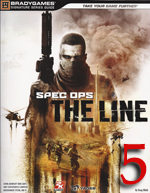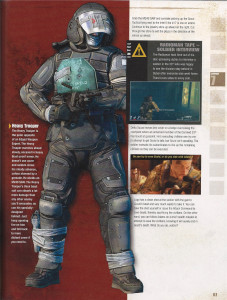 Spec Ops: The Line sprang out of nowhere after E3 with little pomp and circumstance, and it quickly made a name for itself as a military third-person shooter that had a real, honest-to-goodness story. In fact, the game’s story is really one of the only features that stands out about it in comparison with other shooters. Spec Ops has more than a good story; it forces the player to make difficult choices that do affect pieces of the game. With games like this, the strategy guide must do several things: be accurate for both collectibles and with what to expect, present all options as the come up, and above all else, avoid spoilers. The Spec Ops: The Line strategy guide greatly exceeded all expectations.
Spec Ops: The Line sprang out of nowhere after E3 with little pomp and circumstance, and it quickly made a name for itself as a military third-person shooter that had a real, honest-to-goodness story. In fact, the game’s story is really one of the only features that stands out about it in comparison with other shooters. Spec Ops has more than a good story; it forces the player to make difficult choices that do affect pieces of the game. With games like this, the strategy guide must do several things: be accurate for both collectibles and with what to expect, present all options as the come up, and above all else, avoid spoilers. The Spec Ops: The Line strategy guide greatly exceeded all expectations.
The layout of the strategy guide is what makes the guide as excellent as it is. Since the story to the guide itself is linear and rather straight forward, that can create either a guide with lots of white space or an overindulgence with screen captures and art. Much like the strategy guide for The 3rd Birthday, Spec Ops The Line strategy guide brilliantly blends the balance of art, screenshots, and written strategy content that makes each page both aesthetically pleasing and efficient for finding information.
Many times, collectibles in games are just little extra perks, but in Spec Ops, the collectibles unfold more of the story. There’s definitely a greater sense of need in collecting them over merely being a completionist. Spec Ops does not have that many collectibles, but they’re easy to overlook as a few can only be collected shortly before or shortly after a major cut scene in the game. In the front of each chapter, the guide lists how many collectibles the chapter has, what they are, and in what order they can be found in as a heads up. Then, each collectible is clearly marked in the walkthrough section. These aren’t mixed in the walkthrough content, but they’re in separate callout boxes that are positioned in the walkthrough sections where the collectibles are located in the game. The only way that users will miss the collectibles is if they are too busy focusing on and absorbing what they just saw in the game and not occasionally glancing at the guide for the collectibles.
But it’s still very easy to pick up missed collectibles. Once you complete the game, you can replay chapters, and the game conveniently points out how many collectibles you have found in each chapter and how many can be collected. From there, it’s a matter of flipping the guide to the appropriate chapter and picking up the wayward collectible. There’s also an appendix before the multiplayer section that lists all of the collectibles and where to find them. The guide cautions users before using this appendix, however, as it also presents the complete dialogue attached to the collectible. I personally appreciated this part of the guide as I thought about what I had experienced with the game and wanted to recall certain pieces without firing up the Xbox. At least none of these collectibles are spoilers to the overall story.
Aside from the guide layout and collectibles, how did it handle all potential spoilers? I suppose the real answer lies in how much you flip ahead. If you stick with where you are in the game and in the guide, you will never run across a spoiler. Even when the guide presents to you your choices in a particular manner, it will never once tell you what the consequences of your actions are for choosing this over that. It lets you see your choice unfold on the game screen instead of in the guide. For someone like me who wants to always make the best decision at all times, I was both elated and frustrated that the guide wouldn’t come out and say which decision was best. At the same time, it always pointed out choices that weren’t entirely obvious from the game presentation. This was always appreciated.
When a game is as short as Spec Ops: The Lineis, it’s easy to expect the strategy guide–if there even is one–to be short and a bit half-assed. It’s always refreshing to see strategy guides that make the most of it and present a near-perfect blend of strategy and video game art without sacrificing any of the usefulness of the book. After all, there’s nothing worse than a useless strategy guide. The Spec Ops: The Line strategy guide is, by far, one of the best mash-ups of strategy and art I have come across yet.
Even better, all of its written strategy was absolutely flawless.
SGR Rating: 5/5
Author: Doug Walsh
Publisher: BradyGames
Editions Available: Paperback
Acquired via Publisher





Leave a Reply